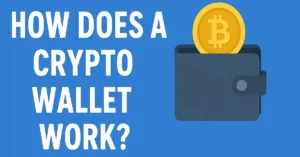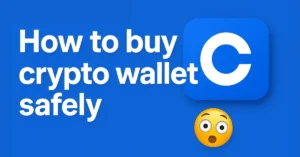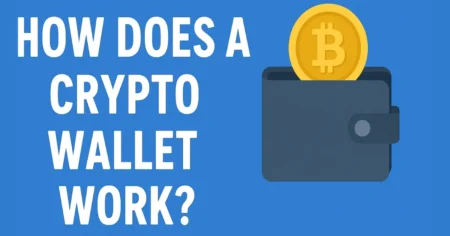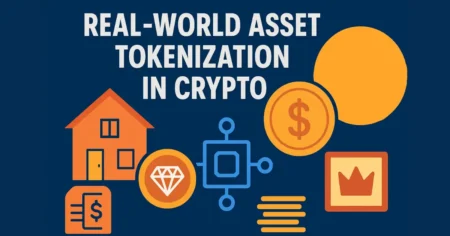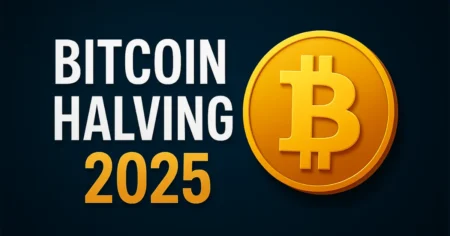Invest $100 in crypto
Investing in cryptocurrency can feel like stepping into a foreign land if you’re new to the world of digital assets. But here’s the truth: you don’t need thousands of dollars to get started. Investing just $100 in crypto can teach you more than hours of reading or endless YouTube videos. It’s all about getting your feet wet and learning by doing wisely.
This guide breaks down everything you need to know to turn a modest $100 into a valuable experience, if not profits. It’s not a get-rich-quick scheme. But with the right mindset and a little patience, $100 can be your ticket into the world of digital finance.
Introduction to Crypto Investing
Why Crypto Is Gaining Popularity
Cryptocurrency has evolved from a tech-nerd fantasy to a global buzzword. You’ve seen headlines—Bitcoin hitting new highs, Dogecoin memes, Ethereum 2.0 upgrades. But what’s behind all the hype?
People are drawn to crypto because it’s decentralized, meaning no single government or bank controls it. It’s borderless, often cheaper to send money, and some believe it’s the future of finance. Plus, let’s be real—watching a coin double overnight is thrilling.
But there’s more to it than fast gains. Blockchain technology—the backbone of cryptocurrency—is revolutionizing industries such as healthcare, real estate, and gaming. And that’s why it’s more than a trend.
Is $100 Enough to Start Investing?
Yes. A hundred bucks might not sound like much, but in the crypto world, it’s more than enough to start. Crypto is highly divisible. For example, you can buy a fraction of a Bitcoin (called a satoshi), so you’re not locked out if BTC is trading at $60,000.
When I started, I put in $100 just to “see what happens.” It wasn’t about profit; it was about learning. And that $100 taught me how to research, manage risk, handle losses—and yes, enjoy wins.
Setting Your Expectations with $100
Understanding Risk and Reward
Here’s the honest part: crypto is volatile. That $100 might turn into $200, or drop to $30 overnight. The key is understanding that investing doesn’t guarantee profits. It’s about playing smart, not playing big.
Risk in crypto is like the weather—unpredictable. But you can prepare. Never invest money you can’t afford to lose. That’s not just advice; it’s survival.
Start with an approach like this:
- Allocate: Divide the $100 across 3–5 coins.
- Research: Never invest based on hype alone.
- Track: Watch how your coins move to learn patterns.
Short-Term vs Long-Term Mindset
Crypto isn’t just for day traders. In fact, with $100, it makes more sense to think long-term. Some coins take time to mature. Bitcoin took 10 years to go from pennies to tens of thousands.
I adopted the HODL mindset (Hold On for Dear Life). I bought Ethereum and left it alone. Six months later, it had nearly doubled. Patience paid off.
But if you’re curious, test both strategies:
- Day trade with $20 just to learn.
- Hold the rest and watch how each behaves over time.
Choosing the Right Crypto Exchange
Features to Look For in a Platform
Your crypto journey starts with choosing the right exchange. It’s where you’ll buy, sell, and sometimes store your coins. But not all platforms are equal.
Here’s what you should look for:
- User-friendly interface: Especially if you’re new.
- Low fees: Avoid platforms that eat into your $100.
- Security: Look for exchanges with 2FA and insurance.
- Crypto variety: More coins = more options.
- Reputation: Read reviews. Check how long they’ve been around.
Recommended Beginner-Friendly Exchanges
Based on my own experience and what beginners generally love, here are the top picks:
- Coinbase: Super easy for newbies. Clean UI.
- Binance: Great for variety and lower fees.
- Kraken: Good for both beginners and advanced users.
- Crypto.com: Offers a mobile-friendly setup with solid rewards.
Each platform has pros and cons. I started with Coinbase because of its simplicity, then moved to Binance when I wanted more options and lower fees.
Personal Experience with Signing Up and KYC
When I signed up, I thought it’d be instant. But most exchanges require KYC (Know Your Customer)—uploading ID, selfie, and sometimes proof of address. It felt like a hassle at first, but it’s meant to protect you.
Coinbase approved me in less than a day. Binance took a little longer. Pro tip: Use clear documents, and don’t get annoyed. It’s just one step before you start exploring.
Best Cryptocurrencies to Invest in with $100
Top 5 Cryptos for Small Investors
With just $100, every dollar counts. So, picking the right coins matters. Don’t just go with what’s trending—understand the purpose behind each.
Here’s my top five list for beginners:
- Bitcoin (BTC) – The OG, less risky but more stable.
- Ethereum (ETH) – Powering DeFi, NFTs, and smart contracts.
- Solana (SOL) – Fast, low-cost, and growing in adoption.
- Polygon (MATIC) – Layer 2 scaling for Ethereum, low fees.
- Chainlink (LINK) – Connects smart contracts to real-world data.
These coins have solid communities, real use cases, and growth potential. I put $20 into each to spread the risk.
Diversifying Your $100 Wisely
Instead of betting all on one, diversification is your best friend. Here’s a sample strategy:
- $25 in Bitcoin (stable, safe bet)
- $25 in Ethereum (growth + DeFi exposure)
- $20 in Solana (new tech)
- $15 in Polygon (low fees)
- $15 in a wildcard (newer project you research)
That’s how I structured my first investment. It gave me exposure to different ecosystems without overcommitting to one.
My First Crypto Portfolio Setup
When I started, I wanted to “feel” the market. So I bought:
- $30 BTC
- $30 ETH
- $20 ADA
- $10 MATIC
- $10 DOGE (yes, for fun)
Guess what? DOGE went up 5x, but I didn’t sell. Why? I didn’t have a plan. Lesson: Even $10 can surprise you, so always have an exit or hold strategy in mind.
How to Buy and Store Crypto Safely
Buying Crypto Step-by-Step
Buying crypto isn’t as complicated as it sounds. Here’s the simple 5-step process I followed when I bought my first coins:
- Sign Up on an Exchange: I chose Coinbase initially. Their UI was clean, and the sign-up was straightforward.
- Verify Identity (KYC): I uploaded my driver’s license, a selfie, and waited a few hours.
- Link Payment Method: Added my debit card to buy instantly. Bank transfer also worked, but was slower.
- Choose Crypto: I picked Ethereum for my first purchase.
- Buy and Confirm: Entered $50, reviewed the fees, hit “Buy,” and boom—I was in the game.
- One lesson: Always double-check what you’re buying. Some coins have similar names (Bitcoin vs. Bitcoin Cash). Don’t get tricked.
Hot Wallets vs Cold Wallets
Once you own crypto, where do you keep it?
- Hot Wallets: These are internet-connected. Think of apps like MetaMask, Trust Wallet, or exchange wallets.
- Pros: Easy access, beginner-friendly.
- Cons: More vulnerable to hacking.
- Cold Wallets: These are offline, USB-like devices such as Ledger or Trezor.
- Pros: Very secure, great for long-term holding.
- Cons: Expensive, less convenient.
If you’re starting with $100, a hot wallet is fine. I used Trust Wallet for my mobile needs. Later, when my portfolio grew, I got a Ledger Nano S for safety.
My First Wallet Mistake (and What I Learned)
I once sent MATIC to the wrong network (Ethereum instead of Polygon). It was stuck and cost me a recovery fee. That mistake taught me two things:
- Always check the network before transferring.
- Never rush—double-check wallet addresses.
- Losing even $10 stings when you only have $100. So, take your time.
Earning Passive Income from Your $100 Investment
Staking Basics
Staking is like earning interest on your crypto. You lock your coins in a network to support its operations and get rewards in return.
Here’s how I staked $50 worth of MATIC:
- I used the Polygon Wallet.
- Selected a validator and delegated my tokens.
- Rewards started coming in weekly.
Not all coins are stakeable. But ones like:
- MATIC
- ADA (Cardano)
- SOL (Solana)
- ETH (after Ethereum 2.0 upgrade)
- …all offer solid staking options.
You don’t get rich, but it’s passive. My $50 earned me about $1.25 in a month. Not much, but it beats doing nothing.
Crypto Savings Accounts
Platforms like Nexo, Celsius (before issues), and Crypto.com offer crypto savings accounts. You deposit, and they pay you interest—sometimes up to 8–12%.
I once deposited $30 worth of USDC on Crypto.com and earned 6% APY. No staking required. Just deposit and chill.
Be cautious, though. If a platform fails, your money might be gone. Only use well-known, regulated platforms.
Real Return Examples from My Portfolio
Let me break it down:
| Coin | Amount Invested | Method | Monthly Return |
|---|---|---|---|
| MATIC | \$50 | Staking | \$1.25 |
| USDC | \$30 | Savings | \$0.90 |
| CRO | \$20 | Staking | \$0.60 |
After a few months, I reinvested my earnings. It’s not fast cash, but it grows, especially if you’re consistent.
Tracking Your Crypto Portfolio
Best Apps for Monitoring Your Investments
When you only have $100 in crypto, it’s tempting to ignore tracking. But trust me, you’ll want to monitor your gains (and losses).
Here are some apps I’ve personally used:
- CoinMarketCap: Great for tracking prices, setting alerts.
- CoinStats: Let’s you sync your wallet and exchanges.
- Blockfolio (now FTX App): Real-time tracking and news in one place.
These apps help you see trends, compare assets, and avoid panic-selling during dips.
Avoiding Emotional Decisions with Tools
Watching your $100 dip to $70 can feel brutal. That’s when people panic and sell at a loss.
Instead of reacting emotionally, use tools:
- Set alerts for price changes.
- Create a stop-loss plan: Decide in advance when you’ll sell.
- Use auto-invest features if available to average out the cost.
I once sold my ADA during a dip, only to see it surge a week later. Lesson? Trust your research, not your gut. Tools help remove emotion.
Crypto Scams to Watch Out For
Common Red Flags
Crypto is the wild west. Scammers love beginners. They know you’re excited, hopeful, and not yet experienced. Here are red flags I’ve learned to spot:
- Promises of guaranteed returns (“Double your BTC in 24 hours!”)
- Fake airdrops or giveaways: Never send crypto to get more.
- Impersonators: Fake profiles pretending to be influencers.
- Fake wallets or apps on app stores.
- Ponzi schemes disguised as DeFi protocols.
- If it sounds too good to be true, it usually is.
My First Brush with a Scam
I fell for a fake giveaway early on. A Twitter account claimed Elon Musk was giving away ETH. All I had to do was “verify my wallet” by sending 0.1 ETH.
I lost $40.
It was a gut punch, but it taught me to:
- Never trust random links.
- Double-check profiles.
- Bookmark real websites.
Now, I triple-check everything and never send crypto blindly.
Taxes and Legal Considerations
How Crypto Is Taxed
Most people overlook this part, but it’s important. In many countries, crypto is treated as property or assets, not currency. That means when you buy, sell, or even earn through staking, it’s often considered a taxable event.
Here’s how it usually works:
- Selling crypto for fiat (USD, GBP, etc.): You pay capital gains tax.
- Trading one crypto for another: Taxable, even if no cash is involved.
- Earning crypto through staking or mining: Counted as income.
I made a rookie mistake by not keeping records in my first year. When tax season came, I had to dig through months of transactions. Now, I log every move using apps like:
- Koinly
- CoinTracker
- ZenLedger
It’s a hassle upfront, but it saves you stress (and money) later.
Tips for Staying Compliant
- Track everything: Dates, coin amounts, values at transaction time.
- Use tax software: Syncs with your wallets/exchanges.
- Know your local laws: Tax rules vary wildly.
- Don’t hide it: Many exchanges now report to tax authorities.
Even if your gains are small, report them. Better safe than audited.
Scaling Up from $100
Reinventing Your Investment Strategy
Once your $100 grows—or you’re ready to invest more—don’t just keep doing the same thing. Your next $500 or $1,000 needs a refined strategy.
Here’s what I learned after scaling up:
- Re-evaluate your coins: Not every early pick deserves more money.
- Balance your portfolio: Maybe go 40% BTC, 40% ETH, 20% altcoins.
- Look into DeFi: Explore yield farming, liquidity pools, and dApps.
- Set goals: Are you investing for retirement? A house? Passive income?
My first $100 taught me what not to do. That knowledge helped me build a better $1,000 plan later.
Reinvesting Profits Intelligently
If your $100 turns into $150 or more, don’t just cash out—reinvest. Consider:
- Dollar-Cost Averaging (DCA): Buy more crypto regularly, no matter the price.
- Diversification: Add new coins or stablecoins.
- Stablecoin yield farming: Put profits into USDC or USDT and earn interest.
I took $30 of my ETH profits and started staking MATIC. It’s like using your crypto to build more crypto safely.
Is It Worth It? A Look Back at My First $100
Wins, Losses, and Lessons
Let me be real: I didn’t become a millionaire. But investing $100 in crypto changed my mindset completely.
- Wins: I turned $100 into $175 in six months. I learned how markets work, how to be patient, and how to spot trends.
- Losses: I lost $40 to a scam and another $10 from a failed altcoin.
- Lessons: Research matters. Hype is dangerous. Time in the market beats timing the market.
That small investment helped me understand bigger principles—like risk management, diversification, and emotional control.
What I Would Do Differently
If I could go back, I’d:
- Start tracking every trade from day one.
- Avoid meme coins unless I’m okay losing that money.
- Set profit-taking targets early.
- Ignore Twitter hype and focus on fundamentals.
That first $100 was more valuable as a learning experience than anything else. And it laid the foundation for everything that came after.
Conclusion
Starting with $100 in crypto might sound small, but it’s more than enough to begin your journey. It’s not about the amount—it’s about the mindset and method.
Crypto can be a rollercoaster. There will be ups and downs, wins and regrets. But by starting small, staying smart, and committing to learning, your $100 can do more than grow—it can educate you in a way no course ever could.
Take your time. Make mistakes. Learn from them. And most of all—enjoy the ride.
FAQs
Can I make money with just $100 in crypto?
Yes, but it depends on timing, strategy, and patience. While big gains are rare, $100 can grow with the right investments and by reinvesting profits over time.
How long should I hold my crypto?
There’s no one-size-fits-all. Some prefer long-term (HODLing), while others day-trade. For beginners, long-term investing usually brings better results.
Which is better: Bitcoin or altcoins?
Bitcoin is the most stable and widely accepted. Altcoins can offer bigger gains—but also bigger risks. A balanced mix of both is often recommended for small investors.
Is crypto better than the stock market for small investors?
Crypto offers higher potential returns but with much more risk. Stocks are more stable. For $100, crypto offers a faster learning curve—but it’s not for the faint-hearted.
How often should I check my crypto portfolio?
Daily checking can lead to emotional decisions. Once a week is a good balance. Set alerts and stick to your strategy.
Also, read
- What is a Crypto Wallet and How Does It Work? – Coinsify
- 10 Crypto Terms Every Beginner Must Know – Coinsify
- What is Blockchain Technology – Complete Guide – Coinsify
- How to Buy Crypto Safely in 2025 – Complete Guide – Coinsify
- Bitcoin vs Ethereum: Key Differences Explained – Complete Guide
- Ultimate Blockchain Glossary: Learn Blockchain Terms Easily
- How to Buy Bitcoin Safely (Complete Beginner’s Guide)
- Top 10 Crypto Wallets for Beginners (2025 Edition)
- What is Cryptocurrency? A Beginner-Friendly Guide (2025)
